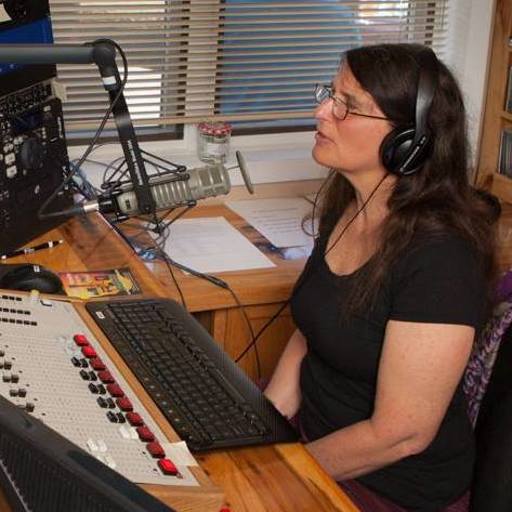This story is a part of Aging Matters, a series from Colorado Matters about the Centennial State's aging population. Read more stories here.
Anyone who’s ever moved knows that the sheer volume of what comes out of those cabinets and closets can be overwhelming.
The problem is magnified for older people who are downsizing from a house they’ve lived in for decades. Lorni Sharrow of Glenwood Springs faced this situation when her mother decided to move from Denver to Florida at the age of 85.
“She had lived in the apartment for 20 years, but she'd lived in Denver all of her life,” Sharrow said. “And things pile up!”
Things like furniture, dishes, Christmas ornaments. It’s not just stuff - it’s a potential emotional minefield.
“Family dynamics are such that you have to be very careful when going through family treasures,” said Sharrow. “And treasure means something different to everybody, right? A treasure to me was a pencil that my mom had on her desk all the time. A treasure to my brother was this incredible chest of drawers. Somebody else wanted pictures.”
Sharrow’s family turned to a professional organizer, Sarah Swank, who works with people of all ages and often helps older people downsize.
“The problem that our society has right now is that everyone has too much stuff,” Swank said.
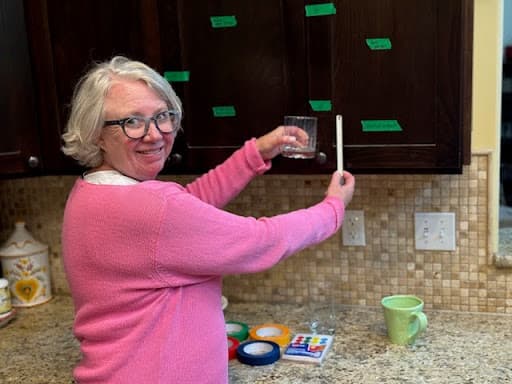
Sorting through the stuff can be an obstacle for people who want to sell a larger home and move to a smaller place. A recent analysis showed older people are staying in larger houses longer, a trend that contributes to the housing crunch by making it harder for younger families to find and afford bigger homes.
Swank offered tips for decluttering and moving when she spoke with Colorado Matters host Chandra Thomas Whitfield, as part of our ongoing series Aging Matters.
First step: address your emotional attachment
“One of the things that happens that's so hard for seniors, is that they have this tremendous emotional attachment to items, and sometimes it's the attachment of connecting the item to the person that they were with when they bought it, or the place, or that time in life. And while you can transfer an object from one person to another, you can't really transfer that emotional tie to someone else.
“And that's why it's so difficult when children don't want things, when other people don't want things, because people feel that their items should be valued by other people in the same way that they value them.
“I think about a client who went all over the world collecting little tiny spoons, and she had this collection of about 3,000 spoons that she was very attached to. But there was no room to bring them, and her children didn't understand the attachment because they weren't part of all of those travels.”
“So sometimes I ask a family to make a memory box. It's sort of similar to, as a mother, when you make a box and you keep your child's artwork and their report cards and the things that you feel proud of in their childhood. Sometimes it's helpful for a family, especially older parents, to just take a bin, a Rubbermaid bin with a lid, and limit themselves to that amount of space. That's a place where you can put all of the important family things that need to go there."
Categorize everything with colored stick-on dots
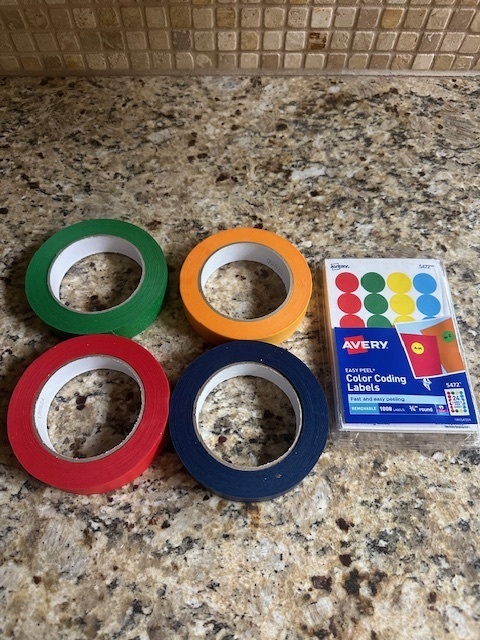
“I choose the ones that have the colors of green, red, yellow, and blue. And the way that I look at the dots is similar to how you would look at a stoplight.
“Green means go. So you put green dots on the things that are going to go with you no matter what. These are the most important things that you have to have.
“Yellow dot items are the same as you would think of when you're coming to a stoplight and it turns yellow. ‘Hold on. Let's think about it. Do we have room? Is there enough space? Am I really going to ever use this or not?’”
“Blue dot items are ones that belong to a specific person, place, or charity. Maybe it's a cookbook that you meant to give back to your friend. Maybe it's a piece of art that your daughter in Cincinnati wants.
“So that, by default, leaves red dot items. And red dots are the items that you say, ‘Stop. Nope, I do not want this.’”
I recently had a client who was so empowered by the idea that she could finally choose to get rid of the things that she felt had weighed her down for so many years, that she actually went through all of my red dots, a whole packet, and bought more. And she probably took 20 things that were green dots, 10 yellow dots and tagged probably 500 things with red dots. And for her, it was just that wonderful feeling of empowerment, of sticking dots on things and feeling like she could now let go of things."
Measure to be sure the things will fit in your new home
“I bring a roll of blue painter's tape again that you can get at Home Depot for $2. We take blue tape and we mark it down on the ground, and then that helps people see how far out items are going to come.
“I think people forget that when they're downsizing, the rooms are smaller and the scale of furniture needs to get smaller as well. The biggest concern is that people move to a tiny little place with a huge couch and a huge coffee table, and then there's no room to get around. Or maybe they have room to get around, but their new friend who has a walker can't get around.”
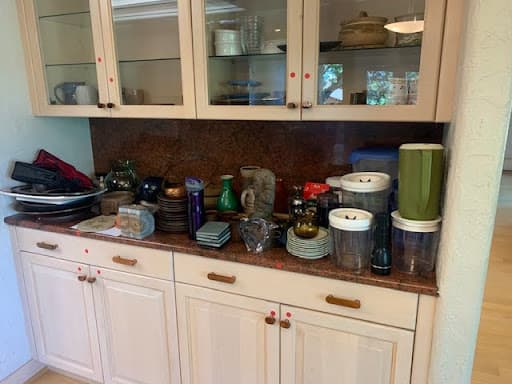
Entire cabinets can be marked with a red dot if they are full of things to be given away or sold. 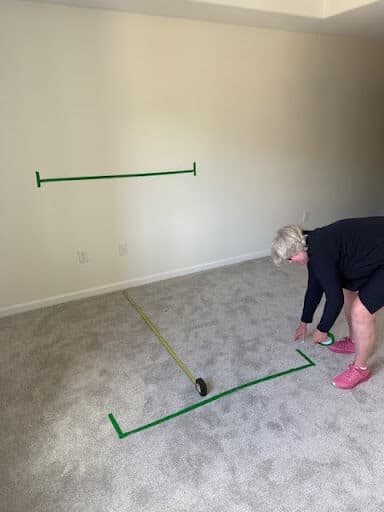
Furniture from a bigger home may not be the right scale for a downsized place. Swank measures out colored tape on the floor.
What do your kids really want?
“What I have found that works really well is to have a family member use an iPhone to take a big video of each room in a house before your parents or grandparents move, open up all the cabinets, open the cupboards, open the drawers, and take a big video. And the reason for that is, if you send that video to all of the children and the grandchildren, nieces and nephews, whoever, it gives everybody an equal chance to see all of the items in there.
“And maybe there's something there that jogs a memory and that's what a grandchild is going to want.
“I remember when my own grandfather was moving to retirement living and I went over to help him with his downsizing, and he took me to a China cabinet and he said, ‘I know you'll want one of these things, these beautiful little items that I bought for your grandmother.’ And I said, ‘I'm so sorry Pop-pop. I don't want any of these things because I wasn't part of that memory.’”
“And I said, ‘The one thing that I want to keep are these little tiny plastic straws with a whistle on them.’ Because when we were growing up, we would go to my grandparents' house and my grandfather would make us pretend cocktails with ginger ale. And then we would blow the whistle and he would come running back and fill up our ginger ale, or our grapefruit soda. And for me, that was the most important thing that I wanted to keep from my grandfather. I miss him a lot."
What to do with photographs
“We've gone through a couple different stages of what to do with photographs. There was a time a few years ago where the best thing to do was to take all of your VHS tapes and your loose photographs, box them up and take them to a freestanding store where they can digitize everything.
“More recently, there have been new apps that come up on iPhones where you can actually download the app that scans a photo and it can help orient all the pictures in the right direction.
“It's a fabulous tool, and you can use that to take pictures of all these pictures, and then it all goes to the cloud, or it can be put on a flash drive or a thumb drive.
“The only other thing I'll say about photographs, old photographs, the black and white photographs, is that if someone in the family remembers who all these people are, it's worth it to take the time to write on the back of the photograph who these people are and something about it. Because the next generation, and the next one, it will be too late and no one will remember anymore.”
Give books a new life
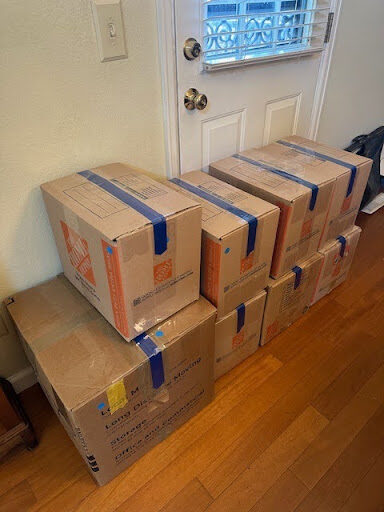
“They should never go to the trash. Never, ever, ever. Books can have a whole new life in a lot of different ways. Some people collect old books, and in that case, the best option is to find someone who will appreciate and buy those books.
“Sometimes people like to buy all of the most current things at Costco, where you can find all the current fiction. In that case, there are bookstores that only buy used fiction, the newer books.
“Everyone used to take all of their books to the Denver Public Library sale, but now I think it's a little bit harder. They have restrictions on how many boxes you can take. So you can take boxes to the Koelbel library, and you can take boxes of books to the little libraries - sometimes when you drive up and down the street, you see those little tiny neighborhood libraries that people put in their front yards.
“I had a client once who asked me to donate all of her books into little libraries, so I just loaded my car up and dropped them all off in various little libraries, up and down streets.
“Dream Books is a great organization which will come and pick up your books. They will pack up all your books and take all of them and figure out what to do with them. So if you don't have the time to figure it out, call Dream Books.”
There are things you can’t give away, no matter how much they cost
“Nobody wants big brown furniture. It's too heavy. It doesn't fit. It's cost prohibitive to move. The younger generation, they live in smaller spaces. They like to be able to move. They love everything from Ikea. It's very much the opposite of what their grandparents and sometimes parents had.
“It's very, very hard because people become attached to the history of old pieces of furniture that were passed down by their mother or their grandmother. And it's very difficult for people to understand that those pieces of furniture are not worth the amount that they paid, or half of what they paid.
“And sometimes, in some instances, not only are they not worth anything, you're going to have to pay somebody to pick them up and remove them. That's a very hard thing for a lot of older people.”
Think about safety when selling items on Facebook marketplace
“I don't generally like the idea of seniors having to have people they don't know come into their home. But I often ask them if they have a neighbor who uses NextDoor. That's a great way to post something that's in your neighborhood.”
Decluttering can unearth long-lost treasures
“Oh, always. Whenever I start, I ask right off the top, are there any items in here that you can't find? Maybe your dad's pocket watch, maybe a certain letter. It's all different kinds of things, but I make a list and I post it usually on the refrigerator so that the people that work with me, or private buyers who might come into the house, can be looking for these items.
“I also find it's really important to ask children, ‘Do your parents hide things? Did they hide money? Did they hide jewelry? Did they hide guns?’ There are all kinds of things that you would like to know about in advance, so that you can be on the lookout for those things.”
If you can’t hire a pro, what friend or family member is best?
“Somebody who's organized and somebody who's objective. This is not the time to have your best friend who went with you on all the trips and bought all this stuff with you. This is the time to have a friend that maybe you don't know that well who offers and says, ‘If there's anything that I can do to help you, let me know.’ That's the person to say, can you come to my house for four hours and keep me on task?”
Almost everyone feels better when the clutter is gone
“I would say 95 percent of them feel incredibly grateful. They feel a huge sense of relief. They feel lighter, they feel happier. They feel untethered or unburdened by all of the stuff that literally has weighed them down.”
| Whether you're aging yourself or caring for someone who is, what questions do you have? Email us at [email protected] or leave a voicemail at 303-871-9191 X 4480. |






